
current / archive / issues / faq / RSS feed / twitter /
Blog Archive: October 2018
A Land Enslaved!The splash page for this story picks up minutes after the end of the last issue, with Doom leaving the French Riveriera by jetpack, talking to himself about how boring it all was and how happy he'll be to get home. His internal dialogue reveals the contradictions that have developed over recent year, between his earlier depiction as a 'hard man' ruler governing his people with an iron rod for their own good, which Roy Thomas has favoured, and the more corrupt, deluded dictator he's been depicted as more recently, especially when written by Stan Lee. Here Larry Leiber hedges his bets, with Doom saying "As a shepherd belongs with his flock, so must a monarch remain with his beloved subjects!" and then immediately adding "... lest the misbegotten dogs grow restive and rebellious in their master's absence!"
There's more of this when he finally arrives home, "How quiet and serene the realm is!" he says to himself. "In the future I must arrange for spontaneous outpourings of joy among the peasantry to greet my homecoming!"
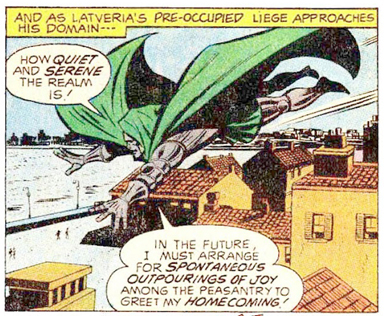 Little does he realise that Latveria has actually been taken over in his absence by the Red Skull, and the populace converted to Nazism. Perhaps this isn't such a leap as it may at first have seemed - after all, during Rudolpho's rebellion the people did seem very keen indeed on hailing him.
Little does he realise that Latveria has actually been taken over in his absence by the Red Skull, and the populace converted to Nazism. Perhaps this isn't such a leap as it may at first have seemed - after all, during Rudolpho's rebellion the people did seem very keen indeed on hailing him.
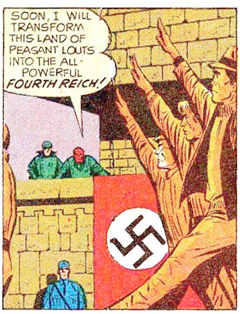 The Red Skull attacks Doom, using the tried and tested method of deploying his own weapons against him. This has happened several times now, and one might have thought that a self-proclaimed genius like Doom would have made sure he had safeguards against all of his own inventions, but once again he falls victim to his own devices, this time "the one weapon I've no defense againts - chemi-sleep gas!" Get some defence against it then!
The Red Skull attacks Doom, using the tried and tested method of deploying his own weapons against him. This has happened several times now, and one might have thought that a self-proclaimed genius like Doom would have made sure he had safeguards against all of his own inventions, but once again he falls victim to his own devices, this time "the one weapon I've no defense againts - chemi-sleep gas!" Get some defence against it then!
Doom is imprisoned in an 'adamantine mummy case' and put on public display to demonstrate the futility of rebellion against the new leadership. The case is designed to heat up, to torture the incumbent, but this time Doom has a plan. All he needs to do is use a 'thermo-energizer', yet another previously unheard of device, which converts heat into power which he then uses to break free. As in previous issues, Larry Lieber seems quite happy to invent new superpowers as he goes along, robbing his stories of tension as the reader just assumes that Doom will remember another gadget that he's never mentioned before which will get him out of bother.
Still, it's a good job he escapes, as at the very moment that new regime is busying itself by shipping people off to concentration camps.
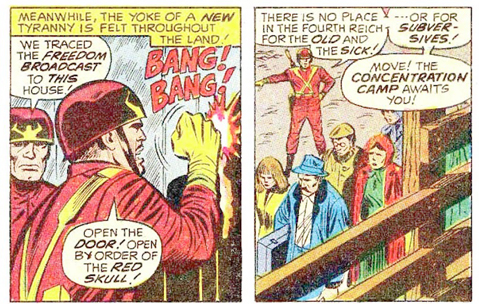 I must admit that this made me feel a little uncomfortable. We know that the Red Skull and his Exiles are Nazis - they tell us all the time and drape swastikas everywhere - but they're presented almost as comedy caricatures, so this sudden reveal of Actual Proper Nazism is a bit of a gut punch. As previously discussed, Lieber is making the baddies as bad as possible to ensure that we can root for Doom as the hero, but this seems to be in rather bad taste.
I must admit that this made me feel a little uncomfortable. We know that the Red Skull and his Exiles are Nazis - they tell us all the time and drape swastikas everywhere - but they're presented almost as comedy caricatures, so this sudden reveal of Actual Proper Nazism is a bit of a gut punch. As previously discussed, Lieber is making the baddies as bad as possible to ensure that we can root for Doom as the hero, but this seems to be in rather bad taste.
Doom charges up to the castle and, never one to make the same mistake twice (well, not all the time) he goes underground, heading for the power station where he finds the fusebox for the weapons systems and switches them all off.
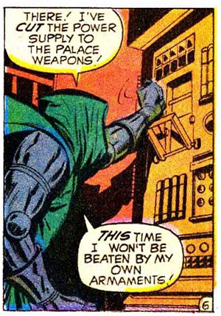 This allows him to get into the main castle, by which point the Skull has ordered his men to "reverse the input lines and attach an auxiliary power box", which means the weapons are back online. The Skull orders the use of a flame-gun, ignoring objections that his own men will be killed, and his men obey.
This allows him to get into the main castle, by which point the Skull has ordered his men to "reverse the input lines and attach an auxiliary power box", which means the weapons are back online. The Skull orders the use of a flame-gun, ignoring objections that his own men will be killed, and his men obey.
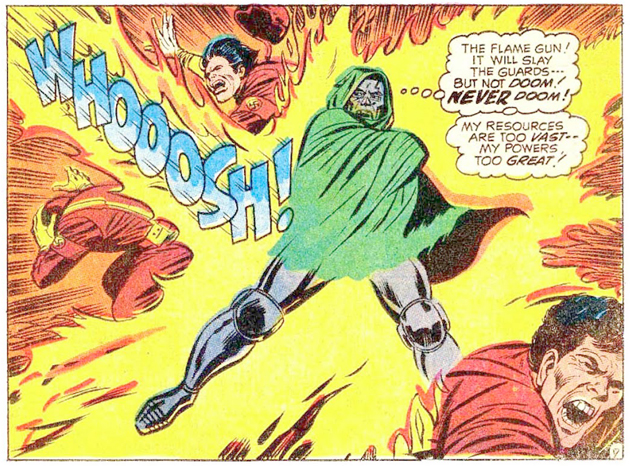 I think this is meant to show how ruthless the Skull is, but it doesn't exactly paint Doom in a great light either. Presumably the men he is fighting are all Latverians who have been forced into service for the Nazis, but Doom is only concerned with his own safety, and does nothing to protect them. This is not the behaviour of a conventional superhero - Doom remains a villain, even if one we're meant to cheer for.
I think this is meant to show how ruthless the Skull is, but it doesn't exactly paint Doom in a great light either. Presumably the men he is fighting are all Latverians who have been forced into service for the Nazis, but Doom is only concerned with his own safety, and does nothing to protect them. This is not the behaviour of a conventional superhero - Doom remains a villain, even if one we're meant to cheer for.
He then plunges the temperature of his armour to "sub-freezing depths" (yet another previously unmentioned power which, surely, would have come in handy when the sarcophagus was boiling him alive) and proceeds to duff up all of the Exiles one by one, chucking them all into an underground room which then fills with gas. The Nazis are convinced it's going to kill them, but then wake up later to discover that it's been used to shrink them instead!
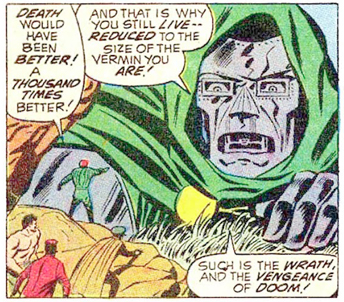 Doom pops them into a miniature rocket and blasts them back to Exiles Island, chortling to himself about the great gag he's played on them - it wasn't shrinko-gas he used, but hypno-gas, which they will wake up from soon and realise they were conned! How this works with regards to his revenge, or why he doesn't kill them, or how he puts them in an actual rocket, are not discussed, and the issue ends with a rather marvellous series of silhouettes from George Tuska, depicting Doom relishing his own brilliance.
Doom pops them into a miniature rocket and blasts them back to Exiles Island, chortling to himself about the great gag he's played on them - it wasn't shrinko-gas he used, but hypno-gas, which they will wake up from soon and realise they were conned! How this works with regards to his revenge, or why he doesn't kill them, or how he puts them in an actual rocket, are not discussed, and the issue ends with a rather marvellous series of silhouettes from George Tuska, depicting Doom relishing his own brilliance.
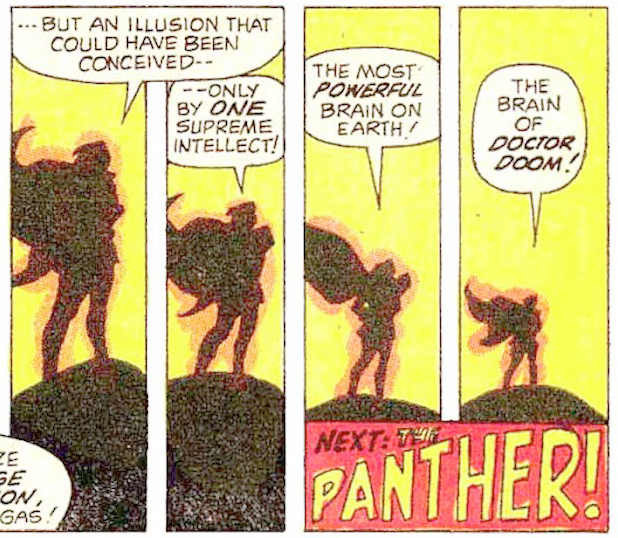 Like most of this series, this has been an odd story which has struggled to find ways to make Doom a lead character whilst still enjoying the villainy that made him a fan-favourite. The method used here, of simply making him fight someone even worse, doesn't work as well as that used by writers like Stan Lee or Roy Thomas, where they try to find reasons for his villainy, and the issue as a whole is at times in rather poor taste. Maybe that's why Larry Lieber tries something a little different in the next story, sending Doom off to fight The Black Panther!
Like most of this series, this has been an odd story which has struggled to find ways to make Doom a lead character whilst still enjoying the villainy that made him a fan-favourite. The method used here, of simply making him fight someone even worse, doesn't work as well as that used by writers like Stan Lee or Roy Thomas, where they try to find reasons for his villainy, and the issue as a whole is at times in rather poor taste. Maybe that's why Larry Lieber tries something a little different in the next story, sending Doom off to fight The Black Panther!
posted 25/10/2018 by MJ Hibbett
(click here for permanent link)
(0) comments
The Invaders!
This story deals with an issue central to the entire series - how do you deal with having a super-villain as the hero of the story? Along the way it has a lot to say about American Cold War attitudes to Eastern Europe.
It starts with Doom standing in the ruins of his castle, apparently continuing directly on from the previous issue two months ago, with no mention of the various other appearances he's had since then. After a very brief recap ("To defeat the rebels I had to destroy my palace!" That's it!) he immediately switches on his video communication system to issue orders to his subjects.
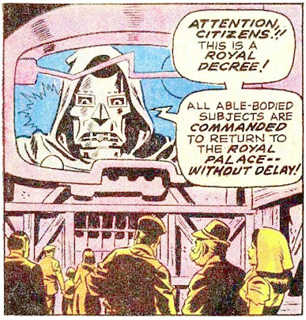 The Latverians trudge along to do his bidding, disgusted with themselves for the way they put up no resistance.
The Latverians trudge along to do his bidding, disgusted with themselves for the way they put up no resistance.
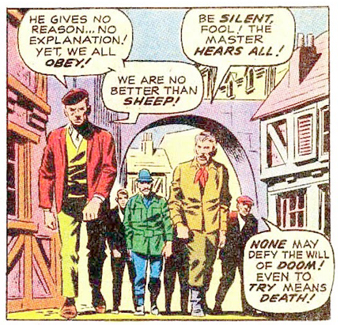 In this story Latveria is standing in for Eastern Europe, and thus its people are viewed with a kind of disdain throughout, as weaklings unable to overthrow the yoke of dictatorship as Americans had two centuries before. They agree to "labour night and day" on Doom's reconstruction project, at which point Doom himself flies off, leaving them to get on with it.
In this story Latveria is standing in for Eastern Europe, and thus its people are viewed with a kind of disdain throughout, as weaklings unable to overthrow the yoke of dictatorship as Americans had two centuries before. They agree to "labour night and day" on Doom's reconstruction project, at which point Doom himself flies off, leaving them to get on with it.
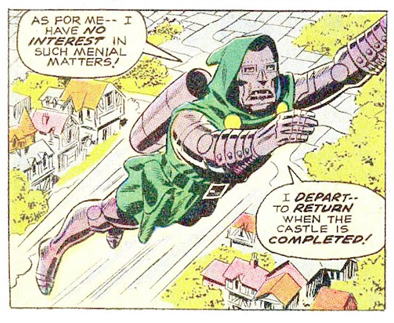 The problem for the storytellers, Larry Leiber and Wally Wood, is that with such an unlikeable character as their lead they need to find a way to make the reader sympathise with him. One way to do this is to have him fight against somebody even worse, and so they bring in pretty much the worst of all villains - the Red Skull.
The problem for the storytellers, Larry Leiber and Wally Wood, is that with such an unlikeable character as their lead they need to find a way to make the reader sympathise with him. One way to do this is to have him fight against somebody even worse, and so they bring in pretty much the worst of all villains - the Red Skull.
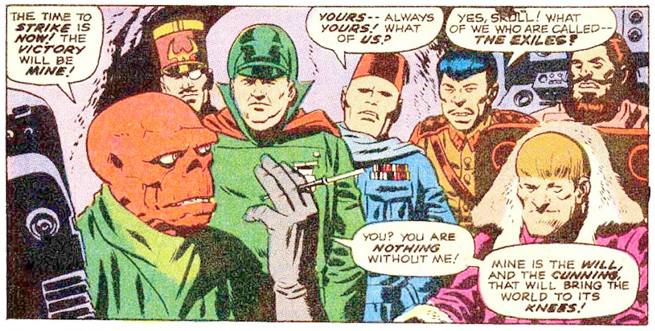 Here we see him hanging around with a group of quite ludicrous national stereotypes - the Exiles, a group of old Nazis looking for somebody to give them direction. The Skull gives them this, taking them wth him to Latveria because "after years of subjugation by Doctor Doom, the Latverians have little spirit left." It's a bit of a risky trade-off if you ask me - the people might be easy to subjugate, but won't their current ruler be a bit annoyed when he comes back?
Here we see him hanging around with a group of quite ludicrous national stereotypes - the Exiles, a group of old Nazis looking for somebody to give them direction. The Skull gives them this, taking them wth him to Latveria because "after years of subjugation by Doctor Doom, the Latverians have little spirit left." It's a bit of a risky trade-off if you ask me - the people might be easy to subjugate, but won't their current ruler be a bit annoyed when he comes back?
The Red Skull seems to think it's worth the risk so he and his gang fly over to the "Story-book kingdom" of Latveria and make short work of beating up the local populace. Meanwhile Doctor Doom has flown down to the Riviera, where he's wandering around the resort, looking for fun.
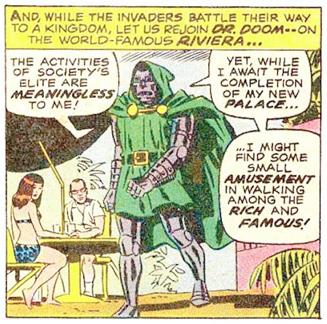 Apart from being a fabulous image, this neatly encapsulates certain US attitudes towards Eastern Europe, and indeed other countries around the globe, during the Cold War. Here we see that as soon as the strong ruler leaves the country it is taken over by much worse characters - the worst of all, in this case. This is an echo of US Foreign policy during this period, when dictators would be supported abroad in the belief that they would at least prevent the arrival of something much worse, whether that be Nazism or Communism. Doom's dalliance at the beach is a metaphor for other dictators losing concentration and becoming (even more) decadent, rather than ruling their people.
Apart from being a fabulous image, this neatly encapsulates certain US attitudes towards Eastern Europe, and indeed other countries around the globe, during the Cold War. Here we see that as soon as the strong ruler leaves the country it is taken over by much worse characters - the worst of all, in this case. This is an echo of US Foreign policy during this period, when dictators would be supported abroad in the belief that they would at least prevent the arrival of something much worse, whether that be Nazism or Communism. Doom's dalliance at the beach is a metaphor for other dictators losing concentration and becoming (even more) decadent, rather than ruling their people.
fter having a couple of thieves try to rob him and being barred from the roulette table Doom soon tires of the life of the idle rich, so he flies off again, looking forward to getting home.
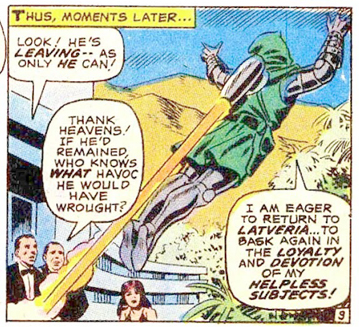 However, there's a very different scene waiting for him when he gets back which... well, let's have a look:
However, there's a very different scene waiting for him when he gets back which... well, let's have a look:
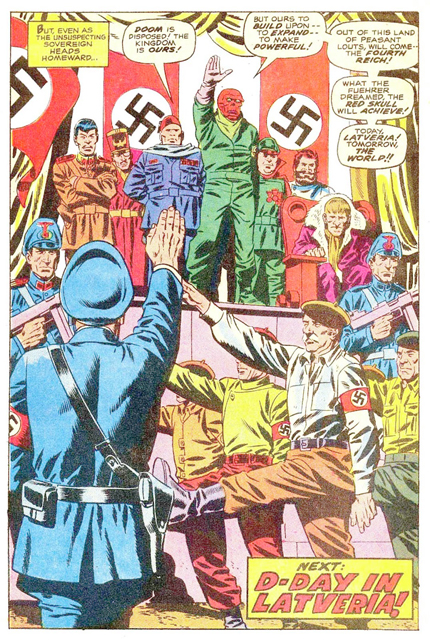 The Latverians have not only been defeated, they are now Actual Nazis! And that's it for this issue, and a story in which Doom has behaved absolutely appallingly, though theoretically less badly than those who wish to oppose him. It's not exactly a ringing endorsement of his leadership and, yet again, it's a very very different portrayal than that which we saw when we were first introduced to Latveria. We'll see how it goes next time, when Doom fights the Nazis!
The Latverians have not only been defeated, they are now Actual Nazis! And that's it for this issue, and a story in which Doom has behaved absolutely appallingly, though theoretically less badly than those who wish to oppose him. It's not exactly a ringing endorsement of his leadership and, yet again, it's a very very different portrayal than that which we saw when we were first introduced to Latveria. We'll see how it goes next time, when Doom fights the Nazis!
posted 19/10/2018 by MJ Hibbett
(click here for permanent link)
(0) comments
Their Mission: To Destroy Stark Industries
Doom only appears in flashback in this issue, which concerns a determinedly mulitnational criminal version of Mission Impossible setting out to bring down Tony Stark's company. While they get ready Tony Stark mopes around thinking about his history as a superhero, musing over some of the adventures that he had with The Avengers.
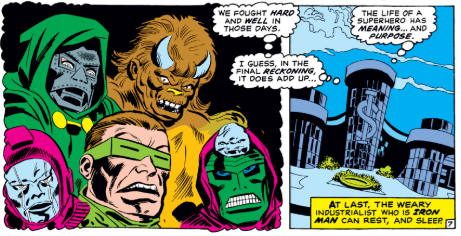 The only problem with this, continuity-wise, is that Iron Man has as yet to met Doctor Doom, at least in the stories published so far. Doom has appeared in a couple of issues of The Avengers, but this was during the Kooky Quartet era and Iron Man was not a member then!
The only problem with this, continuity-wise, is that Iron Man has as yet to met Doctor Doom, at least in the stories published so far. Doom has appeared in a couple of issues of The Avengers, but this was during the Kooky Quartet era and Iron Man was not a member then!
I don't recognise the two villains on the right of the picture, so I guess that the artist, Don Heck, decided he needed to bump up the star quality and, as usual, Doctor Doom was the first choice. We've seen on many occasions that, if there's a gang of baddies, you need Doom in there amongst them to prove that they're proper supervillains, and that seems to be what's happened here!
Next time we're finally back in Doom's own series to find out what happens with The Doomsman - at last!
posted 16/10/2018 by MJ Hibbett
(click here for permanent link)
(0) comments
Trapped In Doomsland!
Doom has his own ongoing story in Astonising Tales during this period, but the fact that that only comes out every other month means that there's plenty of time for Stan Lee to continue with his own version of the character in the second part of a two-parter in Thor.
The story picks up right where the last issue of Thor left off, with the Thunder God being chased by a guided missile. Rather than risk the Latverians below he throws his hammer Mjolnir into the sky, so that the missile will follow that instead. The plan works, but without his hammer Thor crashes to the ground and, after sixty seconds (non) hammer time he transforms back into his human form as Don Blake.
The hammer lands nearby, and the locals wonder whether to go and find it.
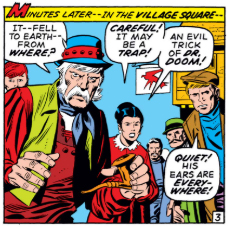 Here we see again how the Latverian people's attitude to Doom has changed. Where once they saw him as a benevolent leader, now he is the head of a terror state with eyes and ears everywhere on his frightened people.
Here we see again how the Latverian people's attitude to Doom has changed. Where once they saw him as a benevolent leader, now he is the head of a terror state with eyes and ears everywhere on his frightened people.
Doom's own delusion about this is shown yet again, believing his own lies about what a kindly ruler he is. "I merely sought to protect you all!" he says after shooting at them with his finger lasers, before attempting to gain the hammer for himself, under the guise of keeping his people safe.
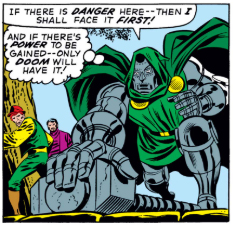 Of course, Doom is not worthy to lift the hammer, so he places it under a protective force field and then stomps back to his lab to set his robot hounds to find the missing Don Blake.
Of course, Doom is not worthy to lift the hammer, so he places it under a protective force field and then stomps back to his lab to set his robot hounds to find the missing Don Blake.
After a brief interlude in Asgard, where we see Odin watching the proceedings, we catch up with Don Blake who has managed to find the missing Professor La Farge, father of Cosette who he promised to help last time. To Blake's surprise the Professor does not want to come with him, apparently convinced that it's a trap set by Doom.
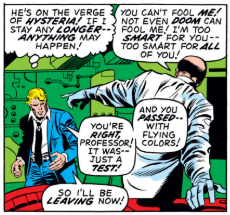 Blake returns to the town square, where he tricks some of Doom's soldiers into blasting a hole in the ground near the hammer. The guards trot off to report their good work to their masters, leaving Blake able to jump into the hole, dig around the edge of the force field and up through the paving slabs, to grab hold of the hammer and turn into Thor again. This whole bit is massively silly - why did they wander off without checking for a body and why did Doom only make the force field semi-circular? - but it does at least get the comic's title character back into action. He flies back into the castle, only to find Doom waiting for him in a fantastic depiction by John Buscema that was destined to be re-used several times for merchandise and advertising.
Blake returns to the town square, where he tricks some of Doom's soldiers into blasting a hole in the ground near the hammer. The guards trot off to report their good work to their masters, leaving Blake able to jump into the hole, dig around the edge of the force field and up through the paving slabs, to grab hold of the hammer and turn into Thor again. This whole bit is massively silly - why did they wander off without checking for a body and why did Doom only make the force field semi-circular? - but it does at least get the comic's title character back into action. He flies back into the castle, only to find Doom waiting for him in a fantastic depiction by John Buscema that was destined to be re-used several times for merchandise and advertising.
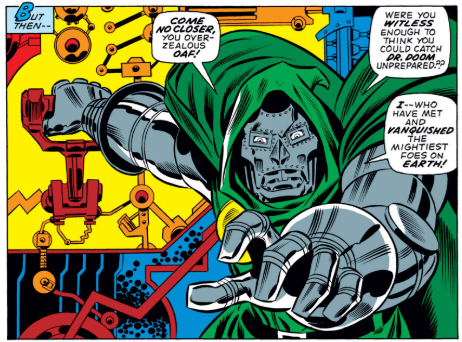 Thor tricks Doom into taking Mjolnir, which he is again unable to hold onto. Unfortunately this leaves Thor weaponless and with only sixty seconds to get the hammer back before he transforms once again. Thor is often spoken of as the most powerful character in the Marvel Universe - the only one, for instance, who could conceivably fight DC's Superman - but Doom puts up a good fight here and almost overpowers him, only losing out due to some loose flooring titles.
Thor tricks Doom into taking Mjolnir, which he is again unable to hold onto. Unfortunately this leaves Thor weaponless and with only sixty seconds to get the hammer back before he transforms once again. Thor is often spoken of as the most powerful character in the Marvel Universe - the only one, for instance, who could conceivably fight DC's Superman - but Doom puts up a good fight here and almost overpowers him, only losing out due to some loose flooring titles.
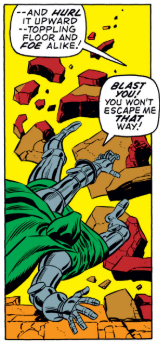 Thor flies out and destroys a whole bunch of missiles - the very missiles that Professor La Farge has spent all these years building - before zooming back to collect the kidnapped scientist. However, when he does, he's in for a rather nasty surprise.
Thor flies out and destroys a whole bunch of missiles - the very missiles that Professor La Farge has spent all these years building - before zooming back to collect the kidnapped scientist. However, when he does, he's in for a rather nasty surprise.
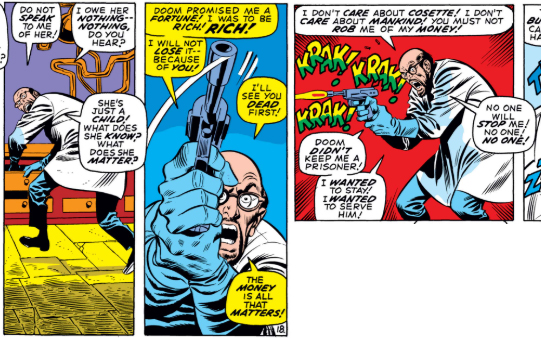 Whoa! So Cosette's version of events was untrue all along - a child's imaging of what had happened, designed to cast her father in a good light whilst all along he was happily in league with Doctor Doom!
Whoa! So Cosette's version of events was untrue all along - a child's imaging of what had happened, designed to cast her father in a good light whilst all along he was happily in league with Doctor Doom!
The Professor accidentally kills himself in a hail of bullets directed at Thor, and dies cursing his daughter's name. Thor leaves the area, more worried about how he's going to explain all of this to Cosette than the threats hurled at him by a furious Doom.
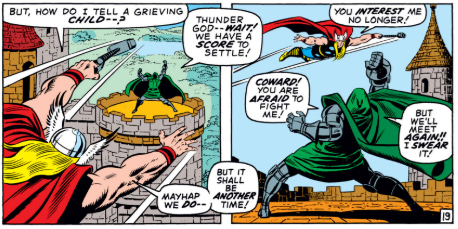 The story ends with Thor back in Manhattan, forced to tell Cosette that his daughter is dead, and coming up with a rather clever way of telling her what happened.
The story ends with Thor back in Manhattan, forced to tell Cosette that his daughter is dead, and coming up with a rather clever way of telling her what happened.
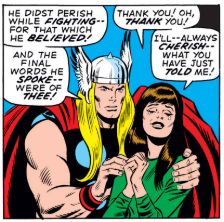 It's all true! As I've said in other recent blogs, it's easy to mock Stan Lee's writing sometimes, but things like this remind you of why he was so successful. It's been an exciting story with moral twists and turns, helped along the way by some gorgeous art by John Buscema. It also includes coherent characterisation of Doom which follows on, and builds upon, the work Stan Lee has done on the character since his creation. The only problem, as we shall see in the next blog, is that it no longer lines up with how other creators are depicting him!
It's all true! As I've said in other recent blogs, it's easy to mock Stan Lee's writing sometimes, but things like this remind you of why he was so successful. It's been an exciting story with moral twists and turns, helped along the way by some gorgeous art by John Buscema. It also includes coherent characterisation of Doom which follows on, and builds upon, the work Stan Lee has done on the character since his creation. The only problem, as we shall see in the next blog, is that it no longer lines up with how other creators are depicting him!
posted 11/10/2018 by MJ Hibbett
(click here for permanent link)
(0) comments
The Fearful Secret of Bucky Barnes!
Doctor Doom cameos in this issue and, as it's written by Stan Lee, he's shown as a pompous despot who'll fall for anything if it means proving his own genius.
In this case he's drawn into a very complicated plan whereby MODOK, head of AIM, has convinced another supervillain to use a body double of Captain America's old sidekick Bucky to try and confuse him (Cap) enough to be defeated in battle. This plan fails, but it turns out that that was all part of MODOK's own scheme, which was to convince Cap that this double was the real deal long enough for him to reveal that - aha! - he was a robot all along, designed to kill him, either by hand or, in the last resort, using an Automatic Destruct Control. Of course, as any long-term comics fan would guess, the plan fails because the robot has Bucky's memories and can't bring himself to murder his hero. Come on MODOK, you've got a massive brain, surely you could have thought this all through beforehand?
The bit involving Doom happens in a flashback when MODOK decides to think back, "to enjoy the success of my plan," which is jolly handy for the reader. He recalls how he recently inflamed student demonstrations past the usual point of disagreement, into a riot very similar to the one seen recently in Thor.
In this case Captain America turns up, and places himself firmly on the side of The Kids.
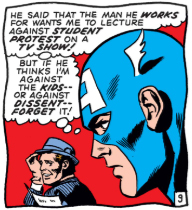 This gives MODOK the idea for his Exploding Robot Duplicate plan and he decides, sensibly, to get the help of the world's greatest Exploding Robot Duplicate manufacturer - Doctor Doom. This is an interesting example of the way that the wide Marvel Universe was used by now - there's no real need, story-wise, for it to be Doctor Doom who builds thr robot, why having him on hand and in continuity means that Lee don't need to bother creating a new character to do it.
This gives MODOK the idea for his Exploding Robot Duplicate plan and he decides, sensibly, to get the help of the world's greatest Exploding Robot Duplicate manufacturer - Doctor Doom. This is an interesting example of the way that the wide Marvel Universe was used by now - there's no real need, story-wise, for it to be Doctor Doom who builds thr robot, why having him on hand and in continuity means that Lee don't need to bother creating a new character to do it.
Of course, they don't really need to show the robot being built at all, but the flip-side is that, with a great character like Doctor Doom available, you might as well.
MODOK uses the oldest trick in the book to get Doom to work for him, issuing him with a challenge and then suggesting that it's impossible, forcing Doom to go odd in a strop, determined to prove him wrong.
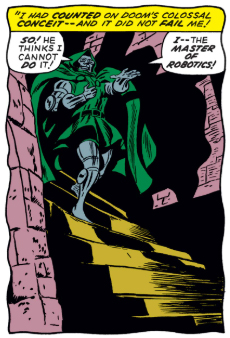 We then get a wonderful Mad Science montage of Doom building the robot which, "thanks to the genius of Dr. Doom" will have "the personality of his human counterpart as well." That definitely was not in the specifications - so it turns out that MODOK's plan collapses because Doom did his work TOO well. This is a neat little touch which, I have to admit, I only spotted myself on the second reading. I guess one can get too used to Stan Lee dashing off stories full of plot-holes and weird turns, so that when he's as clever as he is here, it's easy to miss.
We then get a wonderful Mad Science montage of Doom building the robot which, "thanks to the genius of Dr. Doom" will have "the personality of his human counterpart as well." That definitely was not in the specifications - so it turns out that MODOK's plan collapses because Doom did his work TOO well. This is a neat little touch which, I have to admit, I only spotted myself on the second reading. I guess one can get too used to Stan Lee dashing off stories full of plot-holes and weird turns, so that when he's as clever as he is here, it's easy to miss.
Doom's part in the flashback ends with him handing over the goods, communicating as ever by video.
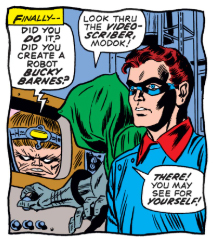 And that's that for what turns out to be a very clever, perfectly in character (or Stan Lee's version of the character at least) version of Doctor Doom. The next time we see him it'll be back in the current continuity, still under Stan Lee's guidance, and back in Latveria.
And that's that for what turns out to be a very clever, perfectly in character (or Stan Lee's version of the character at least) version of Doctor Doom. The next time we see him it'll be back in the current continuity, still under Stan Lee's guidance, and back in Latveria.
posted 9/10/2018 by MJ Hibbett
(click here for permanent link)
(0) comments
Doom Must Die!
This is one crazy comic.
Some of the craziness works in favour of the story, as more and more ideas are piled on, but elsewhere you get the distinct impression that Larry Leiber was making things up as he went along. There's several occasions, for instance, where Doom suddenly uses a new, previously unmentioned power, to get himself out of a fix, often a power which would have solved other problems earlier on in the story with ease.
The splash page shows the last issue's revolution against Doom in full swing, with rocket-powered rebels zooming into the castle where Doom and The Faceless One are still facing off against each other with the Doomsman in the middle. Both Doom and The Faceless One instruct the android to attack the other, and these two equally forceful but opposite commands cancel each other out, leaving him free to exercise his own free will. Because that, apparently, is how voice-recognition software works in Latveria,
Both villains back away from the robot, but then Doom decides to try Mind Fusion, a simple process whereby he can take control of the Doomsman's mind because it is based on his own. I don't recall this ever being mentioned as one of his abilities before, and does lead one to wonder why he didn't try it sooner. ,Still, it works, and the Doomsman turns on The Faceless One, grabbing him an unescapable grip.
It's at this point that we get the best twist in the whole story:
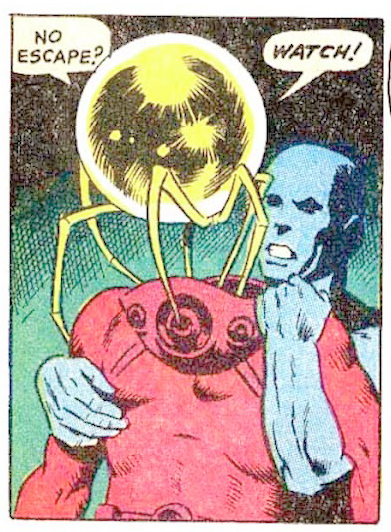 It turns out that The Faceless One is not a humanoid in a round helmet after all, but a weird space ball on robot spider legs! He skitters off, blowing up his body and managing to fool Doom into thinking he's left the castle by sending his spaceship away without him.
It turns out that The Faceless One is not a humanoid in a round helmet after all, but a weird space ball on robot spider legs! He skitters off, blowing up his body and managing to fool Doom into thinking he's left the castle by sending his spaceship away without him.
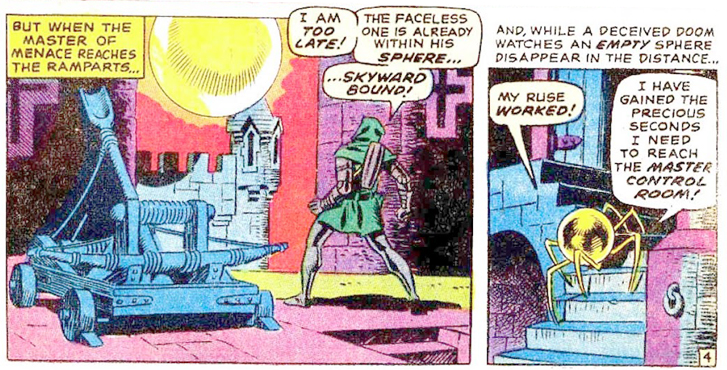 Doom then turns to the other matter on his to-do list - quelling the rebellion. He does this easily by using unspecified "energy" which is "generated by forces far beyond your comprehension", another example of a new super power that could have come in handy on plenty of previous occasions. He's acting like a Silver Age Superman here, seemingly unstoppable with a new power for every occasion.
Doom then turns to the other matter on his to-do list - quelling the rebellion. He does this easily by using unspecified "energy" which is "generated by forces far beyond your comprehension", another example of a new super power that could have come in handy on plenty of previous occasions. He's acting like a Silver Age Superman here, seemingly unstoppable with a new power for every occasion.
Doom immediately finds himself under attack from "Anti-Particles", one of his own inventions that, again, have not been mentioned before. The Faceless One has got into Doom's control room and, rather wonderfully, is also using his favourite method of communication against him.
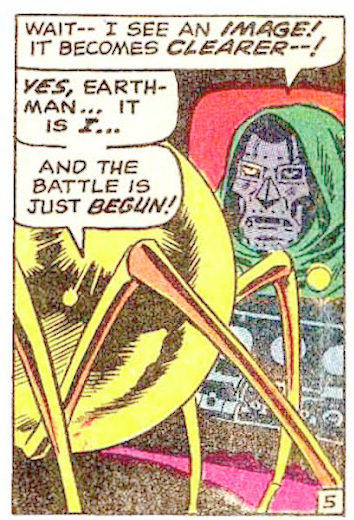 Doom is chased out of the castle by a range of his own weapons, until an astonished group of rebels watch him disappear from existence altogether. Thinking their rebellion has accidentally succeeded, Rudolpho is proclaimed their new ruler and the crowd start doing that slightly dodgy "Hailing" that they're so worryingly keen on.
Doom is chased out of the castle by a range of his own weapons, until an astonished group of rebels watch him disappear from existence altogether. Thinking their rebellion has accidentally succeeded, Rudolpho is proclaimed their new ruler and the crowd start doing that slightly dodgy "Hailing" that they're so worryingly keen on.
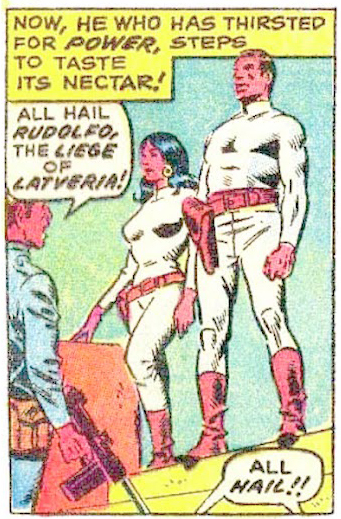 Their happiness does not last long, as the castle starts to vibrate and, up in the sky, a massive image of Doom appears, informing them that he cannot be beaten and, even now, his earthquake generator is destroying the building.
Their happiness does not last long, as the castle starts to vibrate and, up in the sky, a massive image of Doom appears, informing them that he cannot be beaten and, even now, his earthquake generator is destroying the building.
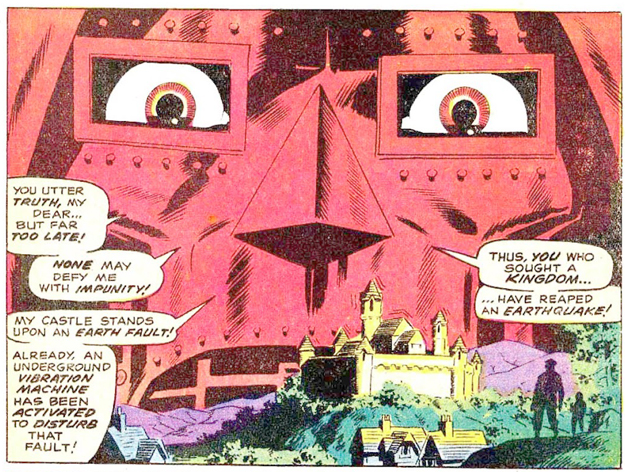 What on earth is going on here? How did he escape whatever weapon the Faceless One turned on him? How did he do the big Sky Face? Why is his castle built on a fault line, and how come there's such a thing in the Bavarian mountains? The only thing that does ring true here is Doom's actions - an earthquake machine is exactly the sort of precautionary device he'd install, and destroying his home to stop somebody else getting hold of it is precisely the reaction you'd expect. Part of the reason this story gets away with as much as it does it that Leiber writes a great Doom, if not a sensible plot, and Wally Wood makes him look very exciting. One does have to wonder though, where are all the robots and soldiers that he usually has access to? Doom may be in character, but Latveria is not.
What on earth is going on here? How did he escape whatever weapon the Faceless One turned on him? How did he do the big Sky Face? Why is his castle built on a fault line, and how come there's such a thing in the Bavarian mountains? The only thing that does ring true here is Doom's actions - an earthquake machine is exactly the sort of precautionary device he'd install, and destroying his home to stop somebody else getting hold of it is precisely the reaction you'd expect. Part of the reason this story gets away with as much as it does it that Leiber writes a great Doom, if not a sensible plot, and Wally Wood makes him look very exciting. One does have to wonder though, where are all the robots and soldiers that he usually has access to? Doom may be in character, but Latveria is not.
The rebels flee, with a much more heroic than usual Rudolpho leading them away, carrying a wounded Ramona in his arms, swearing to try again. Meanwhile the Doomsman is called to The Cave Of Sorrows, another freshly mentioned area, where he finds Doom sitting on a throne. There's no explanation of how he got there.
Doom decides to test the android, freeing him of mind control so he can fight a couple of handy robots (where were they when he needed them earlier?) before attacking Doom himself. Doom takes back control, admits that his plan to create an army of super-powered androids might have been flawed, and then... falls asleep?
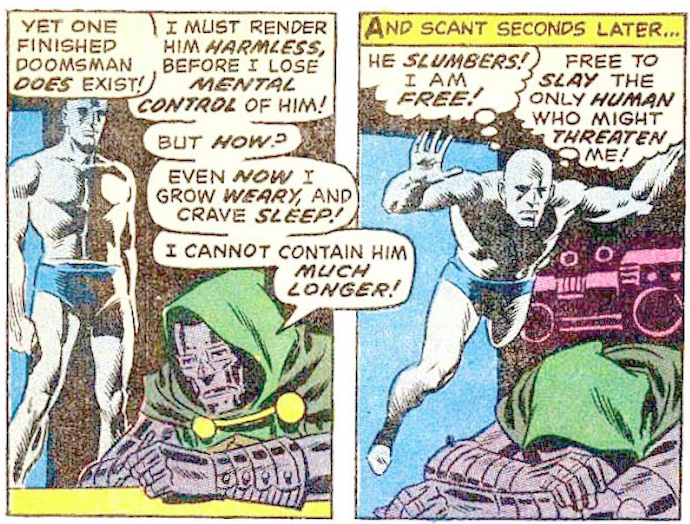 This, of course, was another trap. The android finds it has been freed and goes to attack Doom who reveals that he was just pretending, so teleports the Doomsman into another dimension.
This, of course, was another trap. The android finds it has been freed and goes to attack Doom who reveals that he was just pretending, so teleports the Doomsman into another dimension.
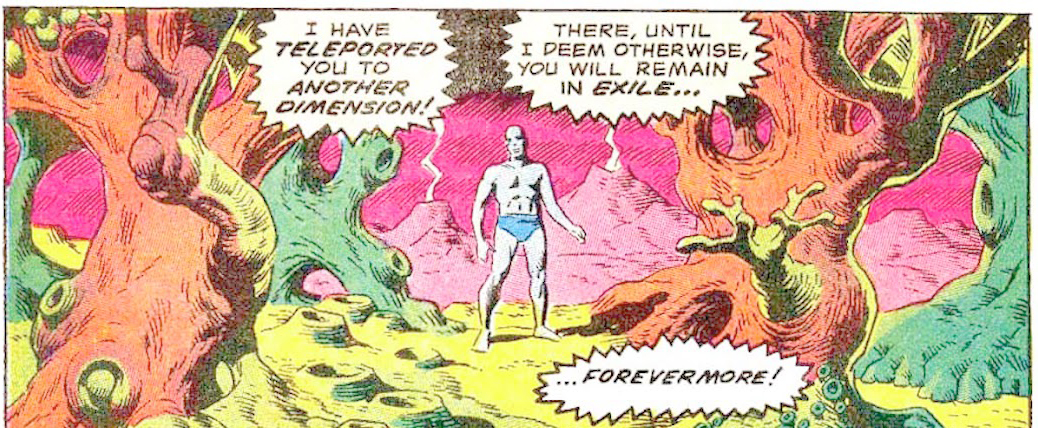 Doom does at least have some history of transporting people to other dimensions, but even so, why did he need to test the Doomsman at all, and again, why didn't he use this power earlier on The Faceless One? Actually, that's a point, isn't he still in the control room?
Doom does at least have some history of transporting people to other dimensions, but even so, why did he need to test the Doomsman at all, and again, why didn't he use this power earlier on The Faceless One? Actually, that's a point, isn't he still in the control room?
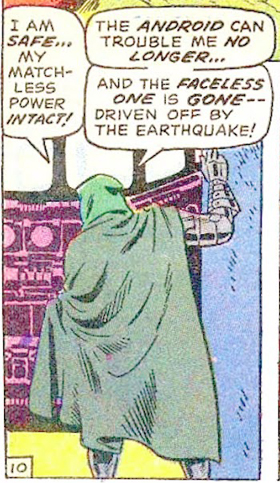 Is it me, or does this feel like Lieber and Wood completely forgot about The Faceless One, and had to stick this bit of dialogue in at the last minute to explain it away?
Is it me, or does this feel like Lieber and Wood completely forgot about The Faceless One, and had to stick this bit of dialogue in at the last minute to explain it away?
And that's the rather rushed end to the story, which finishes with Doom ranting about how he's undefeatable, and the "next time" box offering a challenge.
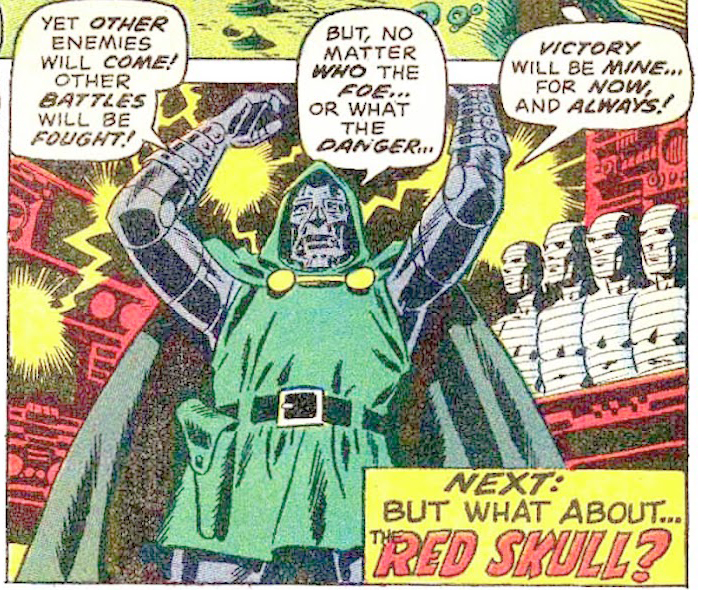 What indeed? Astonishing Tales came out bi-monthly, so it would be a while before regular readers found out... and it'll be quite a while for us too, as there's several other stories between now and then!
What indeed? Astonishing Tales came out bi-monthly, so it would be a while before regular readers found out... and it'll be quite a while for us too, as there's several other stories between now and then!
posted 5/10/2018 by MJ Hibbett
(click here for permanent link)
(0) comments